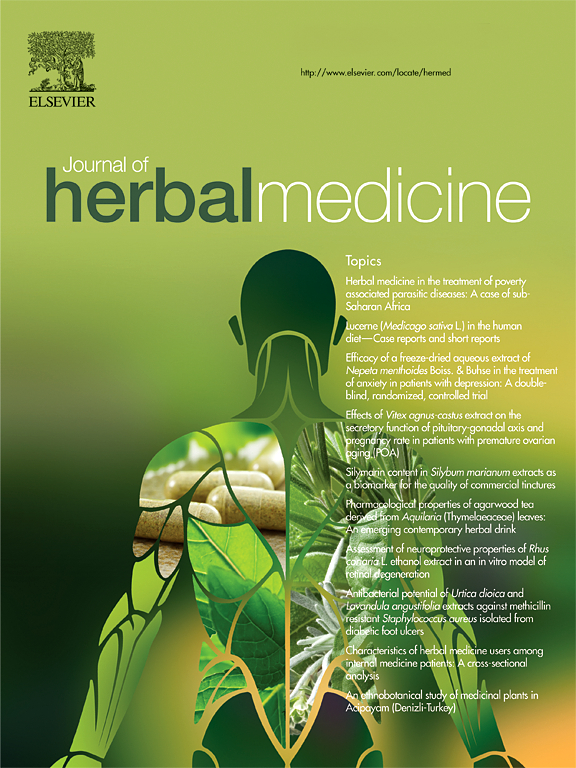Bioactivities, medicinal properties, and advanced extraction techniques of Tarragon (Artemisia dracunculus): a comprehensive review
IF 1.9
4区 医学
Q2 INTEGRATIVE & COMPLEMENTARY MEDICINE
引用次数: 0
Abstract
Introduction
Throughout history, medicinal plants have been used as essential for humans treatment. The antibacterial applications of tarragon (Artemisia dracunculus) in phytotherapy will be covered in this review study. Despite the advancements in pharmaceuticals, herbal remedies continue to be vital, especially in areas where access to modern therapy is limited. In addition, the antibacterial qualities of Tarragon plant extracts and their innovative extraction techniques are described in this review article.
Methods
A thorough examination of the literature looked at the chemical composition, historical uses, and modern extraction techniques of tarragon (A. dracunculus). The extraction techniques, such as the in-syringe reversed dispersive liquid-liquid microextraction (IS-R-DLLME), ultrasound-assisted extraction (UAE), deep eutectic solvents (DES), and pressurised liquid extraction (PLE), and the methods of review analysis the antibacterial properties of tarragon (A. dracunculus) extracts against dangerous microbes.
Results
Both Gram-positive and Gram-negative bacteria can be effectively resistant by tarragon (A. dracunculus) essential oils and extracts. Also the primary bioactive components were limonene, methyl eugenol, and estragole. The yield and purity of bioactive components were enhanced by novel extraction techniques such as IS-R-DLLME and UAE. At minimum inhibitory concentrations (MIC). Therefore, the essential oils demonstrated strong antibacterial action against Escherichia coli and Staphylococcus aureus.
Discussion/Conclusions
The tarragon (A. dracunculus) plant may be regarded as a potent natural antibacterial agent, especially for antibiotic-resistant illnesses. By combining traditional botanical knowledge with contemporary extraction methods, new medicinal compounds can be created. This study highlighted the need to explore the synergistic effects of tarragon's bioactive components and improve extraction methods in order to optimise therapeutic advantages. Ultimately, tarragon (A. dracunculus) may help antibiotic resistance and microbial illnesses.
龙蒿(Artemisia dracunculus)生物活性、药用特性及先进提取技术综述
纵观历史,药用植物一直被用作人类治疗的必需品。本文就龙蒿(Artemisia dracunculus)在植物治疗中的抗菌应用进行综述。尽管药物取得了进步,但草药疗法仍然至关重要,特别是在获得现代疗法的机会有限的地区。此外,本文还对龙蒿植物提取物的抗菌特性及其创新的提取技术进行了综述。方法通过查阅文献,对龙蒿的化学成分、历史用途和现代提取技术进行分析。采用针内反相分散液-液微萃取法(IS-R-DLLME)、超声辅助萃取法(UAE)、深度共晶溶剂萃取法(DES)和加压液体萃取法(PLE)等提取技术,对龙蒿提取物对危险微生物的抑菌性能进行了综述分析。结果龙蒿精油和提取物对革兰氏阳性菌和革兰氏阴性菌均有较好的耐药性。主要生物活性成分为柠檬烯、甲基丁香酚和雌酮酚。采用IS-R-DLLME和UAE等新型提取技术,提高了生物活性成分的收率和纯度。最低抑制浓度(MIC)。因此,精油对大肠杆菌和金黄色葡萄球菌具有较强的抗菌作用。讨论/结论龙蒿(a . dracunculus)植物可能被认为是一种有效的天然抗菌剂,特别是对抗生素耐药性疾病。通过将传统植物学知识与现代提取方法相结合,可以创造出新的药用化合物。本研究强调有必要探索龙蒿生物活性成分的协同作用,改进提取方法,以优化治疗优势。最终,龙蒿可能有助于抗生素耐药性和微生物疾病。
本文章由计算机程序翻译,如有差异,请以英文原文为准。
求助全文
约1分钟内获得全文
求助全文
来源期刊

Journal of Herbal Medicine
INTEGRATIVE & COMPLEMENTARY MEDICINE-
CiteScore
3.90
自引率
0.00%
发文量
94
期刊介绍:
The Journal of Herbal Medicine, the official journal of the National Institute of Medical Herbalists, is a peer reviewed journal which aims to serve its readers as an authoritative resource on the profession and practice of herbal medicine. The content areas of the journal reflect the interests of Medical Herbalists and other health professionals interested in the clinical and professional application of botanical medicines. The objective is to strengthen the research and educational base of herbal medicine with research papers in the form of case studies, original research articles and reviews, monographs, clinical trials and relevant in vitro studies. It also publishes policy statements, opinion pieces, book reviews, conference proceedings and profession related information such as pharmacovigilance reports providing an information source for not only the Herbal Practitioner but any Health professional with an interest in phytotherapy.
 求助内容:
求助内容: 应助结果提醒方式:
应助结果提醒方式:


